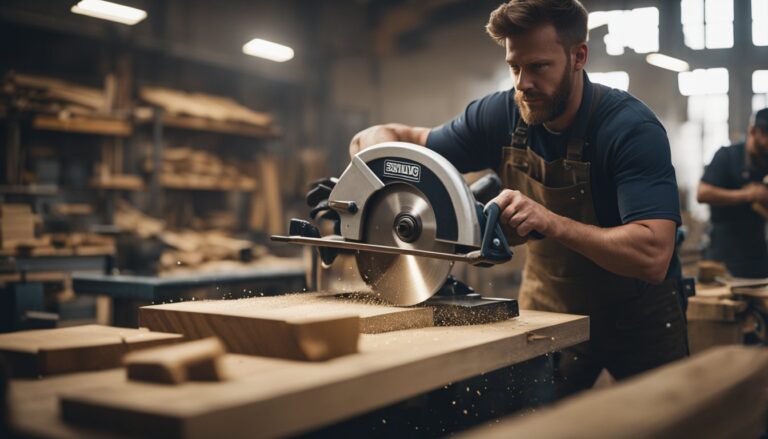Best Jig Saw Blade for Aluminum: Top Picks for Precision Cutting
Cutting aluminium with a jigsaw requires the right blade to achieve clean, precise cuts. Selecting the appropriate blade can significantly improve the quality of your work and the efficiency of your project. The best jigsaw blade for aluminium typically features fine teeth, a bi-metal construction, and a thin kerf.
Aluminum is a soft metal that can quickly gum up saw blades, making cutting challenging. A blade designed specifically for aluminium helps prevent this issue and ensures smooth, accurate cuts. These specialized blades often have between 18 and 24 teeth per inch (TPI) and are made from durable materials to withstand the heat generated during cutting.
When choosing a jigsaw blade for aluminium, consider factors such as the thickness of the material, the desired cut quality, and the speed of cutting required. Some popular options include blades from reputable brands known for their metal-cutting capabilities.
Key Takeaways
- Fine-toothed bi-metal blades with 18-24 TPI are optimal for cutting aluminium.
- Specialized aluminium blades prevent gumming and ensure smooth, accurate cuts.
- When selecting a blade, consider material thickness, cut quality, and cutting speed.
Understanding Jigsaw Blades for Aluminum
Selecting the right jigsaw blade for cutting aluminium is crucial for achieving precise and efficient results. The blade’s material, construction, and teeth configuration significantly affect its performance.
Types of Jigsaw Blades
Jigsaw blades for aluminium cutting come in several varieties. High-speed steel (HSS) blades offer durability and heat resistance. Bi-metal blades combine HSS teeth with a flexible steel body, providing longevity and versatility.
Carbide-tipped blades excel at cutting aluminium. Their hard tungsten carbide teeth maintain sharpness longer than other materials, making them ideal for frequent or heavy-duty aluminium cutting tasks.
Blade Material and Construction
The blade’s material affects its cutting performance and lifespan. HSS blades are suitable for occasional aluminium cutting. Bi-metal blades balance flexibility and durability, making them a popular choice.
Tungsten carbide-tipped blades provide superior cutting ability and longevity when working with aluminium. Their hardness allows them to maintain a sharp edge for extended periods, even under frequent use.
Blade shanks come in two main types: T-shank and U-shank. In most modern jigsaws, t-shank blades are more common and offer quick, tool-free changes.
Teeth Considerations
The number and configuration of teeth on a jigsaw blade impact its cutting performance in aluminium. Blades with fewer teeth per inch (TPI) cut faster but leave rougher edges. Higher TPI blades produce smoother cuts but work more slowly.
For aluminium, blades with 10-24 TPI are typically recommended. Ground teeth offer cleaner cuts compared to milled teeth. Some blades feature a reverse tooth configuration, which helps reduce chipping and provides smoother bottom cuts.
Tooth material also matters. When cutting aluminium, carbide teeth maintain sharpness longer than HSS teeth, resulting in more consistent performance.
Selecting the Right Blade for Aluminum
Choosing the appropriate jigsaw blade for aluminium is crucial for achieving clean, precise cuts. The blade’s tooth count and shank type significantly impact cutting performance and compatibility with different jigsaw models.
Tooth Per Inch (TPI) Range
Blades with 14-24 TPI are ideal for cutting aluminium. Higher TPI counts produce smoother cuts but cut more slowly. A 14 TPI blade offers faster cutting speeds and is suitable for thicker aluminium sheets. For thinner aluminium, 18-24 TPI blades provide cleaner cuts with less burring.
Bi-metal blades are recommended for aluminium due to their durability and heat resistance. These blades combine rigid, flexible steel backs with hardened teeth, efficiently cutting softer metals like aluminium.
Shank Types and Compatibility
Jigsaw blades come in two main shank types: T-shank and U-shank. T-shank blades are more common and offer tool-free blade changes on most modern jigsaws. They provide secure fitment and are less likely to come loose during use.
U-shank blades are older but are still used in some jigsaw models. They require a screw or lever to secure the blade. When selecting a blade for aluminium cutting, ensure it matches your jigsaw’s shank type for proper fit and safe operation.
T-shank blades are generally preferred for their ease of use and broad compatibility. However, if your jigsaw only accepts U-shank blades, quality options are still available for cutting aluminium.
Cutting Techniques and Tips
Proper techniques and adjustments are crucial for achieving clean, precise cuts in aluminium with a jigsaw. Careful attention to blade speed, cutting pressure, and safety precautions ensures optimal results.
Making Smooth Cuts
Use a slow, steady pace when cutting aluminium. Apply gentle pressure to allow the blade to do the work. Clamping the material securely prevents vibration and improves cut quality.
For curved cuts, guide the jigsaw along a pre-drawn line. Make relief cuts in tight curves to reduce blade stress. Cooling the blade with cutting oil or lubricant helps prevent overheating and extends blade life.
To minimize burrs, score the cut line first with a utility knife. This creates a clean starting point for the blade. Consider using masking tape along the cut line to reduce surface scratches.
Safety and Speed Adjustments
Set the jigsaw to a low speed for cutting aluminium. This reduces heat buildup and prevents melting or warping. Most jigsaws have variable speed settings – choose one that is appropriate for metal cutting.
Wear safety glasses and hearing protection. Metal chips can fly during cutting. Gloves protect hands from sharp edges and hot metal shavings.
Ensure proper blade tension before starting. A loose blade can bend or break during use. Check and adjust as needed throughout the cutting process.
If available, use a dust extraction system. This keeps the work area clean, improves the visibility of the cut line, and reduces the inhalation of metal particles.
Top Brands and Market Choices
Several reputable manufacturers offer high-quality jigsaw blades for aluminium cutting. The market provides options balancing performance and affordability for various user needs.
Brands Offering the Best Blades
DeWalt, Bosch, and Milwaukee lead the pack in producing top-tier jigsaw blades for aluminium. These brands are known for their durability and precision. DeWalt’s T-shank blades feature robust construction that is ideal for clean cuts in aluminium sheets. Bosch offers blades with advanced tooth geometry, enhancing cutting speed and longevity.
Milwaukee’s blades boast a proprietary coating that reduces friction and heat buildup during aluminium cutting. For budget-conscious users, Black & Decker provides reliable options that perform well on thinner aluminium materials. Lenox, another respected name, produces blades with bi-metal construction, offering a good balance of flexibility and strength for aluminium work.
Price vs. Quality Balance
Jigsaw blades for aluminium cutting span a wide price range, reflecting differences in quality and performance. Premium blades from DeWalt, Bosch, and Milwaukee typically command higher prices but deliver superior cut quality and longer lifespan. These blades often feature advanced tooth designs and materials that justify their cost for frequent or demanding users.
Mid-range options from brands like Lenox offer a good compromise between performance and affordability. They provide reliable cutting capabilities for most aluminium projects without breaking the bank. Budget-friendly choices from Black & Decker can suffice for occasional use or lighter aluminium work. Users should consider their project requirements and frequency of use when selecting blades to ensure the best value for their needs.
Maintenance and Blade Lifespan
Proper care and timely replacement of jigsaw blades for aluminium are crucial for optimal performance and longevity. Regular maintenance extends blade life while recognizing wear signs ensures consistently clean cuts.
Proper Blade Care
Clean blades after each are used to remove aluminium particles and debris. Use a soft brush or compressed air to clean teeth and gullets. Apply a thin coat of machine oil to prevent corrosion, especially in humid environments. Store blades in a dry place, preferably in a blade case or wrapped in cloth to protect teeth from damage.
Use appropriate speeds and allow the blade to cool between cuts to avoid excessive heat buildup during cutting. This prevents warping and premature wear. Regularly check blade tension and adjust as needed to maintain straight cuts and reduce stress on the blade.
Identifying Blade Wear and Replacement Times
Look for signs of dullness, such as slower cutting speeds, increased vibration, or rough-cut edges. Inspect teeth for chips, missing points, or uneven wear patterns. Bent or warped blades should be replaced immediately to prevent binding and potential injury.
Replace blades when cutting becomes noticeably more complex or requires extra pressure. For frequent users, consider replacing blades every 2-3 months. Light users may extend this to 6 months or more. Keep a spare set of blades on hand to ensure uninterrupted work.
Blade lifespan varies based on usage frequency, material thickness, and cutting techniques. High-quality carbide-tipped blades typically last longer than standard steel blades when cutting aluminium.




